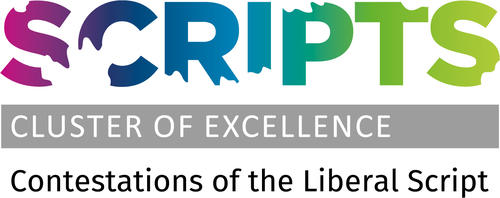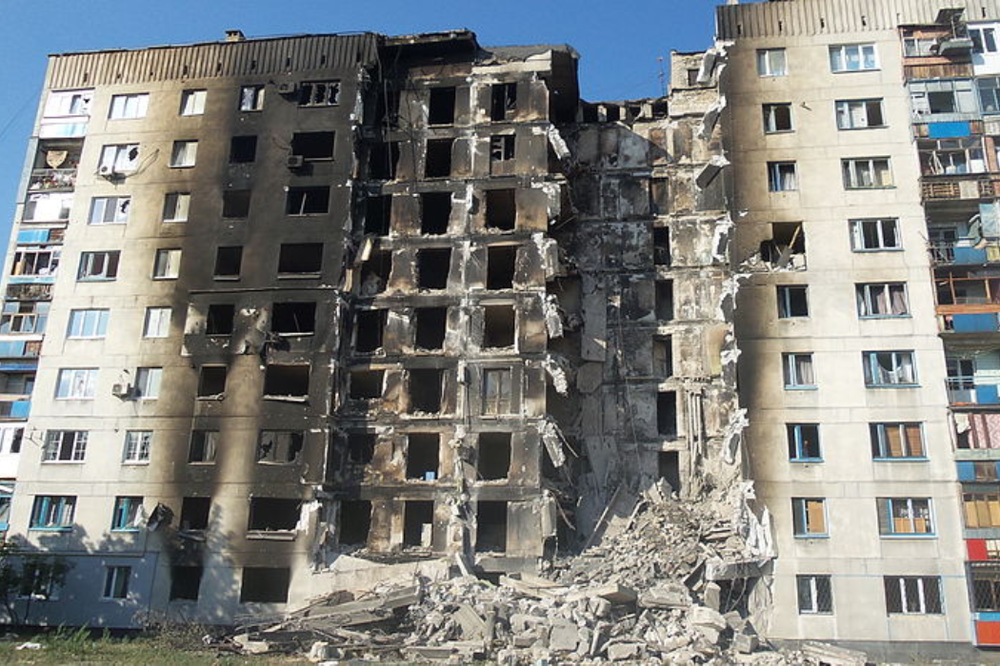War Ruins: The Siege of Mariupol and the Politics of Urban Destruction
SCRIPTS Think Piece No. 13 by Adam Bregnsbo Fastholm
№ 13/2022 from May 17, 2022
Mariupol has been “wiped off the face of the earth”, local observers commented. The destruction of built environment is a gruesome aspect of the ongoing Russian invasion of Ukraine. Adam Bregnsbo Fastholm calls for seeing the obliteration of people’s built surroundings as urbicide – a distinct form of political violence that follows particular patters and exerts horrid effects. On the symbolic level, the dismantling of buildings as artefacts of shared culture also destroys common identity, history, and memory. On the material level, spatial preconditions for community are annihilated.
Apartment building destroyed during War in Donbass. Lysychansk, Lugansk region.
Image Credit: Ліонкінг on Wikimedia Commons.
On 02 March, Russian forces completely besieged the Ukrainian port city of Mariupol before proceeding to gradually tear the city apart, bomb by bomb, week after week. Artillery shelling and aerial bombardment exhibited their gruesome effects in the densely packed urban space killing thousands while obliterating apartment blocks, schools, maternity hospitals, and drama theatres alike. The Red Cross characterised the destruction as “apocalyptic” and a local police officer described the city as “wiped off the face of the earth.” [1] By 18 April, Ukrainian officials reported that at least 95 percent of the city had been damaged or destroyed. Meanwhile, a ghastly array of images from the city displayed the skeletal remains of bomb-shattered buildings reduced to ruins or rubble. [2]
This violent obliteration of people’s surroundings is in no way confined to the ongoing Russian invasion of Ukraine. On the contrary, history is replete with purposeful destruction of built environment: The razing and subsequent cursing of Carthage, the firebombing of Dresden, the systematic demolition of Bosnian cultural heritage, the pulverisation of Grozny and Aleppo, and the nuclear destruction of Hiroshima and Nagasaki. Warfare is closely associated with cities and their undoing.
Yet, the destruction of built environment is often relegated to a position of peripheral importance being viewed as careless collateral damage or as an instance of wanton destruction. Such explanations obscure how the destruction of buildings can be purposeful in and of itself; that the shattering of architecture constitutes a distinct form of political violence following its own patterns, consistencies and logics that are not reducible to military necessity, collateral damage, or irrational vandalism. [3]
The politics of murdered cities
But what is then at stake when buildings are not merely obstacles in the way but targets themselves? What happens if we approach their destruction as events in their own right; as a distinct category of political violence?
Let us begin by naming it. The phenomenon can be subsumed under the concept of urbicide. Lexically, urbicide describes the ‘killing’, ‘slaying’, or ‘slaughter’ (Latin: caedere) of the ‘city’ (Latin: urbs). The term was devised by the science fiction and fantasy author Michael Moorcock and has been used to designate both urban restructuring and the military annihilation of urban fabric [4].The image of a city killed, slayed or slaughtered is certainly evocative but what does it entail? Etymologically and conceptually, urbicide is related to the concept of genocide – the deliberate destruction of a people. The killing of a people and the killing of a city are, of course, not equivalent. The ‘-cide’ of genocide is different from that of urbicide. Humans are living beings; buildings are inanimate matter. Buildings can be restored; human lives cannot. Yet, it is important not to underestimate the crucial social importance of architecture and infrastructure.
Buildings are both constituted by and constitutive of social and political existence. Human beings shape their material environment and are, in return, shaped by it. As Sara Ahmed reminds us, individual and collective “[b]odies take the shape of the very contact they have with objects and others.” [5] We are constantly in contact with buildings: we sleep in them, dream in them, wake up in them, work in them, think in them, seek shelter in them, and interact with them as practical, aesthetic, and symbolic objects. Our movement through the world is oriented by them. Buildings are nodal points in the complex ecologies and infrastructures that provide for and reproduce life. [6] In buildings, different human beings come together and forge collective identities through shared experiences, histories, and memories. Traces of past affective encounters are embedded in the materiality of the buildings surrounding us, shaping us. [7]
As such, the destruction of buildings as artefacts of shared culture can be viewed as tantamount to, if not integral to, “cultural genocide”, as Martin Shaw among others contend. [8] The bombing of the Donetsk Regional Drama Theatre in Mariupol, for instance, not just damages a physical edifice but also destroys a symbol of Ukrainian culture, history, and memory. UNESCO has, as of 14 April, reported damage to more than 100 sites of cultural heritage in Ukraine, including the Ivankiv Historical Museum, the Dormition Cathedral in Kharkiv, and the Babi Yar Holocaust Memorial Center. [9] The destruction of shared culture deprives people of shared identity, history, and memory.
Urbanity, plurality, community
It is, however, not enough to narrowly focus on culturally significant buildings and the symbolic register of urbicide. Their destruction is embedded in a grisly massacre of built environment all over Ukraine that does not limit itself to symbolic structures alone. Urbicide targets an aspect of buildings that exists irrespective of the symbolic qualities ascribed to them.
According to Martin Coward, this aspect is nothing less than the ‘urban’ itself. [10] “Just as genocide refers to the killing of individuals qua representatives of a particular group, so urbicide refers to the destruction of buildings qua representatives of urbanity.” [11] The ‘urban’ refers both to particular configurations of built environment and to the specific existential mode of life characteristic of such an environment. To specify this mode of life, Coward draws on Martin Heidegger to offer a philosophical account of built environment and shared spatiality. To Heidegger, existence is embodied, localised, and oriented towards a specific worldly context. [12] Existence is essentially spatial, and buildings are constitutive of these worlds within which humans are situated. [13] Because buildings are – in principle if not always in practice – publicly available, the spatiality of built environment is fundamentally shared and, hence, plural. [14] As such, there is an ineluctable alterity and plurality inherent in the shared spatiality of urbanity. Buildings “comprise the condition of possibility for an existential heterogeneity.” [15]
The self never exists in isolation but is always constituted in terms of relation. All Being is a Being-with. [16] Community, the philosopher Jean-Luc Nancy contends, is the name we can give to the experience of existing in plural with others; of being exposed to the constitutive possibility of heterogeneity. [17] As built environment comprises the material precondition for encountering heterogeneity, the public, shared spatiality of urbanity is constitutive of community. [18] Moreover, the concrete human bodies comprising community are reliant on built infrastructure that provide for and sustain life: hospitals, shelter, sewerage, and the architecture through which food, water, and energy is distributed.
This is what is fundamentally at stake in urbicide: it constitutes a violent spatial reorganisation of built environment that annihilates the condition of possibility for a plural, heterogeneous, infrastructurally sustained community. This is not to suggest that the Russian military deliberately targets architecture based on readings of Heidegger and Nancy. Rather, I argue that the erasure of the spatial preconditions for community constitutes a consequential aspect of Russian bombing, shelling, and demolition. An aspect that functions at a material rather than purely symbolic level.
Urbicidal horror
Urbicide contains an element of horror. Urban disfigurement forcefully reminds us of the frailty and impermanence of human life and man-made artefacts. At least since antiquity, the eerie symmetry between ruins and the human body has been a recurring theme. [19]Ruins embody anxieties about human aging, deterioration, and death. Probably because buildings are normally expected to last. Bricks, cement, concrete, and metal do not wither away easily, after all. The human world, as Hannah Arendt points out in The Human Condition, receives its reality and reliability from being surrounded by “things more permanent than the activity by which they were produced.” [20]
To watch buildings that have been a constant throughout one’s whole life meet an untimely, violent end is a horrifying, shocking, and disorienting experience – symbolically, sensorially, and affectively. The recognizable forms of buildings pulverised into unidentifiable ruins, shards, rubble, and debris evoke the recurring artistic trope of memento mori, a reminder of the inevitability of death – and of the horrors of war. “To be sure, a cityscape is not made of flesh”, Susan Sontag powerfully writes. “Still, sheared-off buildings are almost as eloquent as body parts [...] This is what war does. War tears, war rends. War rips open, eviscerates. War scorches. War dismembers. War ruins.” [21]
[1] Sunita Patel-Carstairs, ‘Ukraine war: Videos show apocalyptic destruction in Mariupol as Russia says it is ‘tightening its encirclement’’, available at: https://news.sky.com/story/ukraine-war-videos-show-apocalyptic-destruction-in-mariupol-as-russia-says-it-is-tightening-the-noose-12569115. Last accessed 21 April 2022; CBS, ‘Russians push deeper into port city of Mariupol as locals plead for help: “Children, elderly people are dying”’, available at: https://www.cbsnews.com/news/mariupol-russia-ukraine-war-locals-plead-for-help/. Last accessed 21 April 2022.
[2] Holly Ellyatt, ‘Mariupol hasn’t surrendered to Russia, PM says; at least 5 dead, 20 injured in Kharkiv attack’, available at: https://web.archive.org/web/20220418074649/https://www.cnbc.com/2022/04/17/russia-ukraine-live-updates.html Last accessed 21 April 2022.
[3] Martin Coward, Urbicide: The politics of urban destruction (London: Routledge, 2009).
[4] Michael Moorcock, ‘Dead God’s Homecoming’ in Elric: The Stealer of Souls (New York: Ballantine Books, 2008); Andrew Herscher, ‘American Urbicide’, Journal of Architectural Education 60, no. 1 (2006), pp. 18–20.
[5] Sara Ahmed, The Cultural Politics of Emotion (Edinburgh: Edinburgh University Press, 2004), p. 1.
[6] Stephen Graham, ‘Cities and Infrastructure’, International Journal of Urban and Regional Research 24, no. 1, pp. 114–119; AbdouMaliq Simone, ‘People as Infrastructure: Intersecting Fragments in Johannesburg’, Public Culture 16, no. 3 (2004), pp. 407–429.
[7] Ahmed, The Cultural Politics of Emotion; Robert Bevan, The Destruction of Memory: Architecture at War (London: Reaktion Books, 2016).
[8] Martin Shaw, What Is Genocide? (Cambridge: Polity Press, 2007).
[9] UNESCO, ‘Damaged cultural sites in Ukraine verified by UNESCO’, available at: https://www.unesco.org/en/articles/damaged-cultural-sites-ukraine-verified-unesco. Last accessed 21 April 2022.
[10] Coward, Urbicide; Martin Coward, ‘Against Anthropocentrism: The Destruction of the Built Environment as a Distinct Form of Political Violence’, Review of International Studies 32, no. 3 (2006), pp. 419–437.
[11] Coward, Urbicide, p. 15.
[12] Martin Heidegger, Being and Time (Oxford: Blackwell, 1962).
[13] Coward, Urbicide; Martin Heidegger, ‘Building Dwelling Thinking’ in Poetry, Language, Thought (New York: Harper Colophon Books, 1971).
[14] Ibid.
[15] Coward, Urbicide, p. 15.
[16] Heidegger, Being and Time; Jean-Luc Nancy, The Inoperative Community (Minneapolis: University of Minnesota Press, 1991); Jean-Luc Nancy, Being Singular Plural (Stanford: Stanford University Press, 2000).
[17] Coward, Urbicide; Nancy, The Inoperative Community.
[18] Coward, Urbicide.
[19] Svetlana Boym, ‘Ruinophilia: Appreciation of Ruins’, available at: http://monumenttotransformation.org/atlas-of-transformation/html/r/ruinophilia/ruinophilia-appreciation-of-ruins-svetlana-boym.html. Last accessed 21 April 2022.
[20] Hannah Arendt, The Human Condition (Chicago: Chicago University Press, 1998), p. 95f.
[21] Susan Sontag, Regarding the Pain of Others (New York: Picador, 2003), p. 4.
Adam Bregnsbo Fastholm is doctoral researcher at the Berlin Graduate School for Global and Transregional Studies (BGTS). He holds an M.A. in Political Science from the University of Copenhagen. In his dissertation, he examines the spatialities, temporalities, and biopolitics of European border camps.

